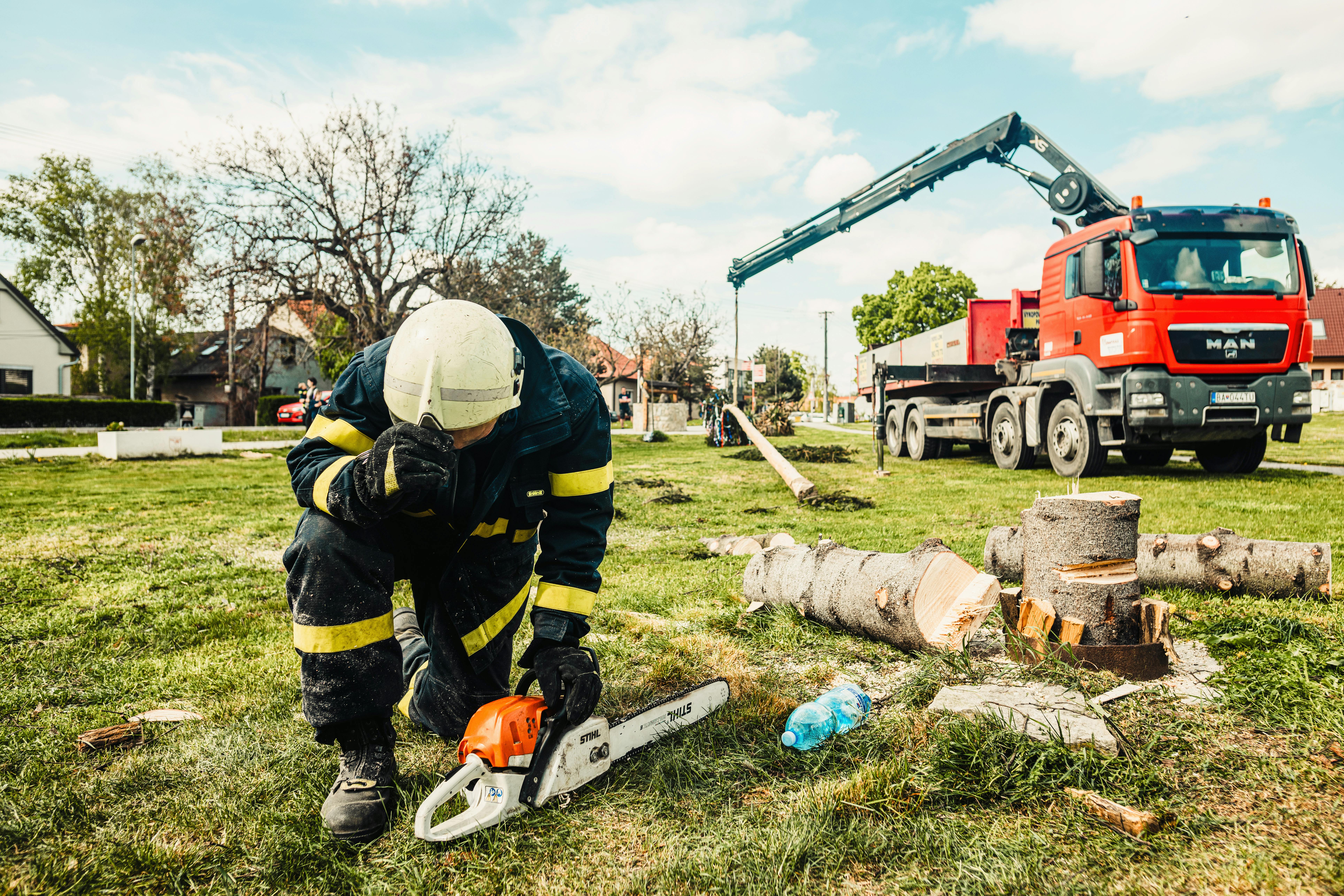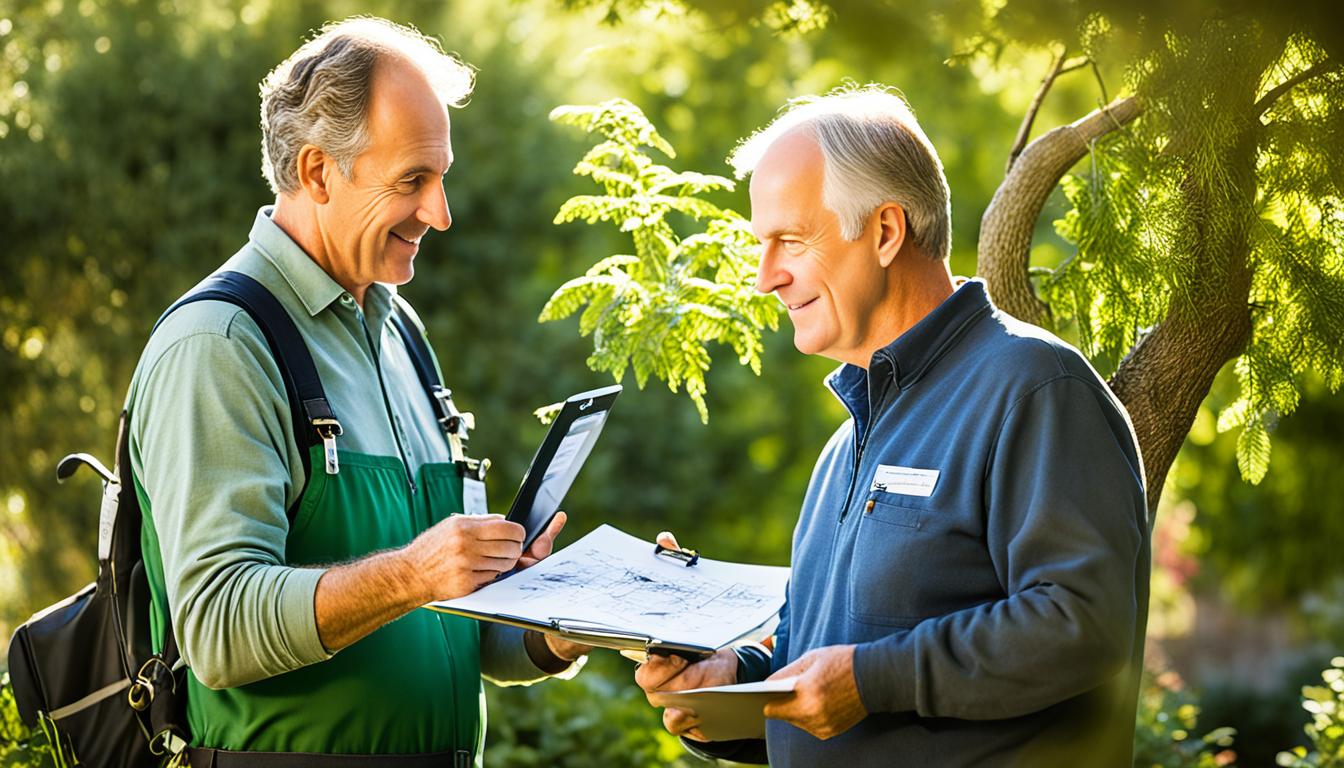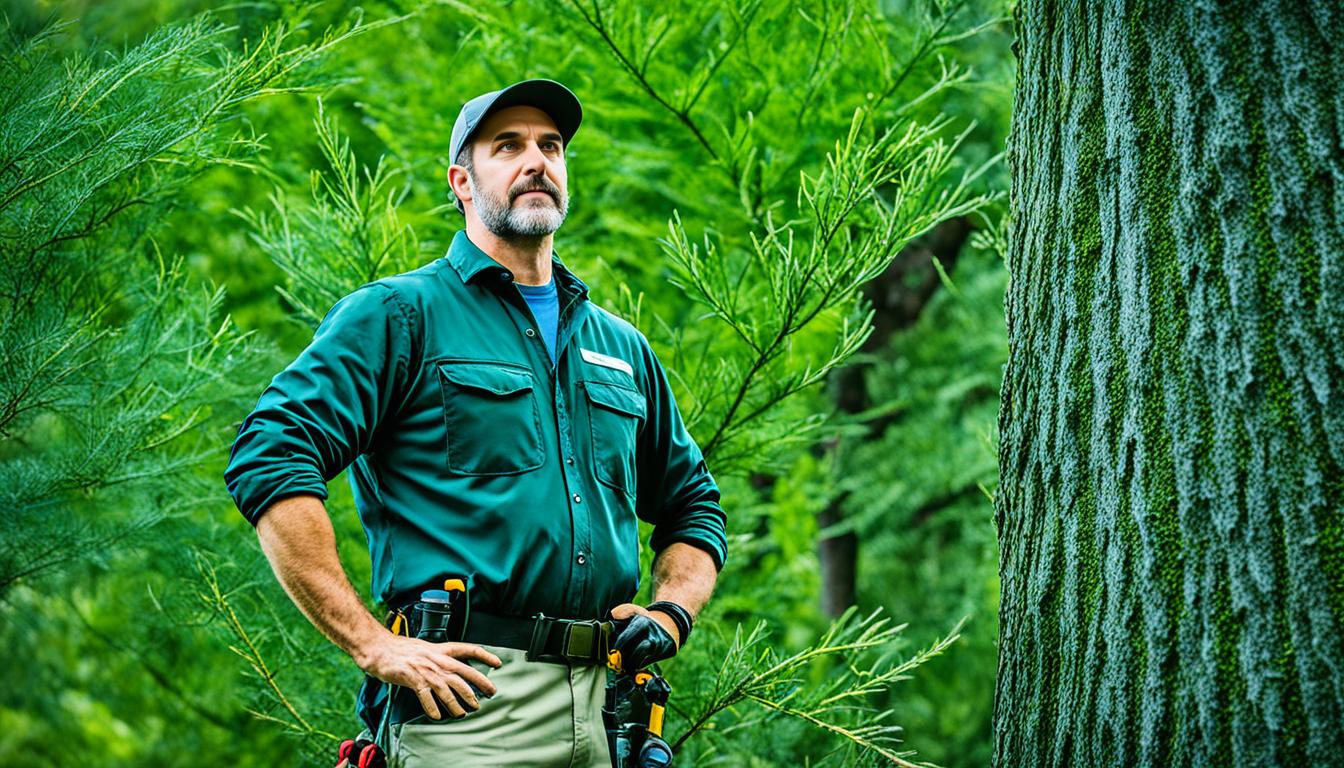Did you know that consulting an arborist before spring planting can make all the difference in the health and success of your garden? With the arrival of spring, many gardeners are eager to start planting new trees and flowers. However, without the guidance of an arborist, you may be setting yourself up for costly mistakes and disappointing results.
An arborist is a certified tree care professional who specializes in the cultivation, management, and maintenance of trees and plants. Their expertise can help you make informed decisions about pruning and trimming, emergency tree care, landscape planning, tree selection, and proper tree planting techniques.
By consulting an arborist like Buck’s Tree Service, you can ensure that your spring planting efforts yield a beautiful and thriving garden.

Key Takeaways:
- Consulting an arborist before spring planting is crucial for the health and success of your garden.
- An arborist can provide expert advice on pruning and trimming, emergency tree care, landscape planning, tree selection, and proper tree planting techniques.
- Choosing the right tree for your yard requires considering factors such as weather conditions, yard size, and the environment.
- Proper tree planting techniques, including site assessment and providing optimal planting conditions, are essential for a tree’s survival and growth.
- When selecting an arborist, look for certification, commitment to safety, and friendly customer service.
Pruning and Trimming
Pruning and trimming are crucial aspects of your spring planting plan. Before you introduce new plants to your garden, it is essential to take care of your existing trees and shrubs. Pruning and trimming allow for the removal of dead or heavy branches, promoting new growth and ensuring the thriving of your trees during the spring season.
By following proper pruning practices, you can prevent the risk of pests, diseases, and breakage in both your existing and new plants. Incorrect pruning techniques or neglecting pruning altogether can leave your plants vulnerable to various issues, compromising their health and longevity. To avoid these risks, it is highly recommended to consult an arborist who can provide expert guidance and ensure the proper care of your plants.
When consulting with an arborist, they will assess the specific needs of your trees and shrubs, addressing any potential pest or disease concerns. They will also identify and remove any damaged or overgrown branches, improving the overall health and appearance of your plants.
The Benefits of Proper Pruning and Trimming
Proper pruning and trimming offer several benefits to your garden:
- Enhanced growth: Removing dead or heavy branches allows for the redirection of nutrients towards new growth, encouraging healthier and lusher foliage.
- Avoidance of disease and pests: Pruning helps eliminate areas that are susceptible to disease and infestations, reducing the risk of spreading to other plants.
- Prevention of breakage: Trimming removes weakened or overgrown branches that may pose a threat during heavy winds or storms.
- Improved aesthetics: Pruning helps maintain a neat and well-maintained appearance, enhancing the visual appeal of your garden.
Consulting an arborist will ensure that your pruning and trimming practices align with the specific needs of your plants and promote their overall health and longevity.
| Incorrect Pruning Practices | Correct Pruning Practices |
|---|---|
| Stub cuts: Leaving stubs behind after pruning, which can lead to decay and pest infestations. | Clean cuts: Making clean cuts just above the branch collar or bud, promoting proper healing and growth. |
| Topping: Removing large sections of the canopy, which weakens the tree and leads to excessive regrowth. | Canopy thinning: Removing specific branches to achieve a natural, balanced appearance while preserving the tree’s structural integrity. |
| Over-pruning: Removing an excessive amount of foliage, hindering the tree’s ability to produce energy through photosynthesis. | Selective pruning: Removing only the necessary branches, allowing the tree to maintain its energy production and overall health. |
Emergency Tree Care
Winter storms can wreak havoc on trees, leaving them damaged and posing a risk to both new plants and your safety. When faced with hazardous trees or downed trees after a winter storm, it’s crucial to seek the assistance of an arborist’s emergency tree services. These professionals are trained to handle tree-related emergencies and can safely remove hazardous trees from your property.
Addressing damaged trees before planting new ones is essential to creating a safe environment. By prioritizing emergency tree care, you can minimize the risk of falling branches or unstable trees that could harm your property or loved ones. An arborist’s expertise can ensure that any damaged or hazardous trees are properly assessed and safely removed, providing you with peace of mind.
When selecting an arborist for emergency tree care, look for a reputable service provider with experience in dealing with winter storm damage. Consider their qualifications and certifications, such as those from the International Society of Arboriculture (ISA). These certifications ensure that the arborists have the necessary knowledge and skills to handle emergency situations safely and effectively.
Benefits of Arborist’s Emergency Tree Services
- Swift and safe removal of damaged or hazardous trees
- Prevention of further property damage
- Minimization of safety risks
- Expert assessment of tree conditions
- Professional advice on tree care and replacement
By addressing emergency tree care needs before planting new trees, you create a safer environment for your garden and home. Prioritizing the well-being of your existing trees helps lay the foundation for healthy and thriving new plantings in the future.

Landscape Planning
Developing a well-thought-out landscape plan is critical before embarking on your spring planting journey. By consulting with an arborist, you can ensure that all the critical components of your landscape plan are in place, setting the stage for a successful and thriving garden.
Key Elements of a Landscape Plan
When creating your landscape plan, there are several important factors to consider:
- Tree Removal: Assessing the need for tree removal is essential in creating space for new plantings and ensuring the safety of your property.
- Planting Location: Choosing the ideal planting location based on sunlight exposure, soil conditions, and proximity to existing structures is crucial for the long-term health of your plants.
- Plant Selection: Selecting the right plants for your landscape involves considering factors such as climate, soil type, and personal preferences.
- Planting Timing: Determining the appropriate time for planting ensures that your plants have the best chance of survival and establishment.
- Tree’s Chance of Survival: Understanding the unique needs of each tree species and considering its specific requirements is vital to maximize its chances of survival and growth.
- Growing Space: Allowing adequate growing space for your plants ensures that they have room to thrive and reach their full potential.
Consulting an arborist will help you navigate these critical components of your landscape plan, ensuring that you make informed decisions that promote the health and longevity of your plants.

| Benefits of Landscape Planning | How an Arborist Can Help |
|---|---|
| Optimizes plant health and growth | Assesses existing landscape to identify areas for improvement |
| Increases aesthetic appeal | Provides guidance on suitable plant selection |
| Minimizes risk of tree failure or damage | Determines optimal planting locations |
| Creates a functional outdoor space | Advises on planting timing for optimal plant establishment |
A well-executed landscape plan sets the foundation for a beautiful and thriving garden. By consulting an arborist, you can ensure that every aspect, from tree removal to plant selection and planting timing, is carefully considered, resulting in a landscape that flourishes for years to come.
Tree Selection
Choosing the right tree for your yard can be a daunting task, considering the wide variety of species available. However, with the expertise of trained arborists, you can ensure that you select the most appropriate tree for your specific needs and environment.
When it comes to tree selection, several factors come into play, including the weather conditions in your region, the size of your yard, and the overall environment. Trained arborists have the knowledge and experience to consider these aspects and guide you towards choosing a tree that will thrive and contribute to the beauty of your landscape.
First and foremost, a trained arborist will take into account the weather conditions in your region. Different tree species have specific preferences when it comes to temperature, precipitation, and seasonal variations. By considering your region’s climate, an arborist can recommend trees that are well-suited to your area’s weather conditions, ensuring their resilience and longevity.
The size of your yard is another crucial factor in tree selection. Trained arborists will assess the space available to determine the appropriate tree size that will fit harmoniously within your landscape. Whether you have a small urban garden or a spacious backyard, the arborist’s expertise will help you choose a tree that won’t outgrow its surroundings or present any safety hazards.
Furthermore, the environment in which the tree will be planted is an essential consideration. Factors such as soil pH, drainage, and sun exposure can significantly impact a tree’s growth and health. By evaluating your yard’s specific environment, a trained arborist can identify the tree species best suited to thrive in those conditions, ensuring optimal growth and beauty.

| Factor | Considerations |
|---|---|
| Weather Conditions | Choose a tree species that is well-adapted to your region’s climate, ensuring its resilience and ability to withstand seasonal variations. |
| Yard Size | Select a tree that will fit harmoniously within your landscape, considering both its mature size and the available space in your yard. |
| Environment | Evaluate the specific conditions of your yard, including soil type, water drainage, and sun exposure, to choose a tree that will thrive in that environment. |
By consulting a trained arborist, you can ensure that your tree selection process is based on expert knowledge and consideration of these essential factors. With their guidance, you can confidently choose an appropriate tree that will enhance the beauty of your yard and contribute to a healthy and vibrant ecosystem.
Tree Planting
Proper tree planting is essential for the tree’s survival and growth. While you may have the perfect spot in mind, there are several factors you need to consider before digging a hole. An arborist will assess the site for sun exposure, soil type, water drainage, and space for growth. Planting a tree in poor conditions can impede its growth or even lead to its death. It’s essential to consult an arborist to ensure that you choose the right spot for planting and provide the necessary conditions for the tree to thrive.
Before you plant a tree, a site assessment by an arborist is crucial to determine the suitability of the planting location. Factors such as sun exposure, soil type, and water drainage can greatly impact the tree’s health and growth. The arborist will assess the available space for growth, ensuring that the tree has enough room to spread its roots and branches.
Soil type plays a vital role in the tree’s survival. The arborist will evaluate the soil’s composition, looking for adequate nutrient levels and proper structure. They can recommend amendments or methods to improve the soil if necessary.
In addition to soil conditions, sun exposure is another critical consideration. The arborist will assess the site’s exposure to sunlight throughout the day to determine if it meets the tree’s requirements. Some trees thrive in full sun, while others prefer partial or full shade. Ensuring the right amount of sunlight will contribute to the tree’s overall health and growth.
Water drainage is also important for the tree’s survival. An arborist will evaluate the site’s natural water drainage patterns to avoid planting in areas prone to waterlogging. Proper drainage will prevent water accumulation around the tree’s roots, minimizing the risk of root rot and other water-related issues.
To maximize the tree’s chances of survival, planting conditions must be optimal. An arborist can provide guidance on proper planting techniques, including digging the right-sized hole, backfilling with appropriate soil, and watering the tree correctly after planting.
Benefits of Consulting an Arborist for Tree Planting:
- Expert assessment of the site for sun exposure, soil type, and water drainage
- Ensuring adequate space for the tree’s growth
- Recommendations for soil amendments if needed
- Determining the appropriate sun exposure for the tree’s species
- Evaluating water drainage patterns to prevent water-related issues
- Guidance on proper planting techniques for optimal survival
By consulting an arborist for tree planting, you can ensure that your tree has the best possible start for healthy growth and long-term survival.
What to Look for When Selecting an Arborist
When it comes to selecting an arborist for your tree maintenance needs, it’s important to consider a few key factors. By choosing the right arborist, you can ensure the safety and health of your trees while receiving top-notch customer service and expertise. Here’s what you should look for when selecting an arborist:
ISA Certification
One of the most important credentials to look for when selecting an arborist is ISA Certification. The International Society of Arboriculture (ISA) provides certification to arborists who have demonstrated a high level of knowledge and expertise in the field. By choosing a certified arborist, you can have confidence in their skills and abilities to care for your trees effectively.
Certified Arborists
In addition to ISA Certification, it’s essential to choose an arborist who is certified. Certified arborists have undergone extensive training and have met specific requirements to earn their certification. This certification ensures that they have the necessary skills and knowledge to provide professional tree care services.
Commitment to Safety
Safety should always be a top priority when selecting an arborist. Look for an arborist who prioritizes safety in their work practices and follows industry standards and guidelines. A commitment to safety not only protects your trees but also minimizes the risk of accidents or damage to your property during tree maintenance.
Customer Service
Good customer service is an essential aspect of any successful arborist service. Choose an arborist who is friendly, responsive, and attentive to your needs. A reliable arborist will listen to your concerns, address any questions you may have, and provide clear and comprehensive explanations of the services they will perform.
Cost Estimates
Before hiring an arborist, it’s crucial to obtain cost estimates for the tree maintenance services you require. A reputable arborist will provide you with upfront and transparent cost estimates, allowing you to budget accordingly. This ensures that there are no surprises when it comes to the financial aspect of tree care.
By considering these factors and selecting an arborist who has ISA Certification, is certified, prioritizes safety, offers excellent customer service, and provides cost estimates, you can rest assured that your trees will receive the best care possible. Make an informed choice and entrust your tree maintenance needs to a qualified and experienced arborist.
Conclusion
Spring planting is an exciting time for garden enthusiasts, but it’s important to take the necessary steps to ensure the health and success of your garden. Consulting an arborist, such as those from Buck’s Tree Service, can provide you with professional advice and guidance throughout the process. From pruning and trimming to emergency tree care and landscape planning, arborists have the expertise to address all aspects of your garden’s health.
By consulting an arborist, you can benefit from their knowledge and experience in maintaining garden health. With their guidance, you can make informed decisions about tree selection, proper planting techniques, and landscape planning. They will help you assess the specific needs of your garden and provide tailored solutions that will set your plants on the path to a blooming and thriving garden.
Don’t leave the success of your spring planting to chance. Contact Buck’s Tree Service today to schedule a consultation and get the professional advice you need to make the most of your garden. With the right expertise and care, your spring planting can bring you the joy of a beautiful and flourishing garden for years to come.
FAQ
Consulting an arborist before spring planting is important to ensure proper pruning and care for existing plants, address any tree damage from winter storms, develop a landscape plan, choose the right tree for your yard, and ensure proper tree planting for optimal growth and health.
Pruning and trimming help remove dead or heavy branches, allowing your trees to produce new growth and thrive. It prevents pests, diseases, and breakage that can affect both existing and new plants.
Winter storms can leave trees damaged, posing a risk to new plants and safety. Consulting an arborist for emergency tree services can help remove hazardous or downed trees before you start planting.
An arborist can assist you in making important decisions such as tree removal, planting location, plant selection, and planting timing. They ensure a well-thought-out landscape plan that maximizes plant health and growth.
A trained arborist can help you choose the most suitable tree based on weather conditions in your region, the size of your yard, and your specific needs. Their expertise ensures you select an attractive tree well-suited to the environment for optimal growth and health.
Proper tree planting ensures the tree’s survival and growth. Factors such as sun exposure, soil type, water drainage, and space for growth need to be considered. Consulting an arborist helps choose the right spot and provide the necessary conditions for the tree to thrive.
When selecting an arborist, it’s important to choose one who is certified by the International Society of Arboriculture (ISA) for knowledge and expertise. Look for a friendly arborist committed to safety, offering customer service and upfront cost estimates.
Consulting an arborist, such as those from Buck’s Tree Service, before spring planting ensures professional advice and guidance to ensure the health and success of your garden. From pruning and trimming to emergency tree care and landscape planning, arborists have the knowledge and experience to make your spring planting journey a success.

